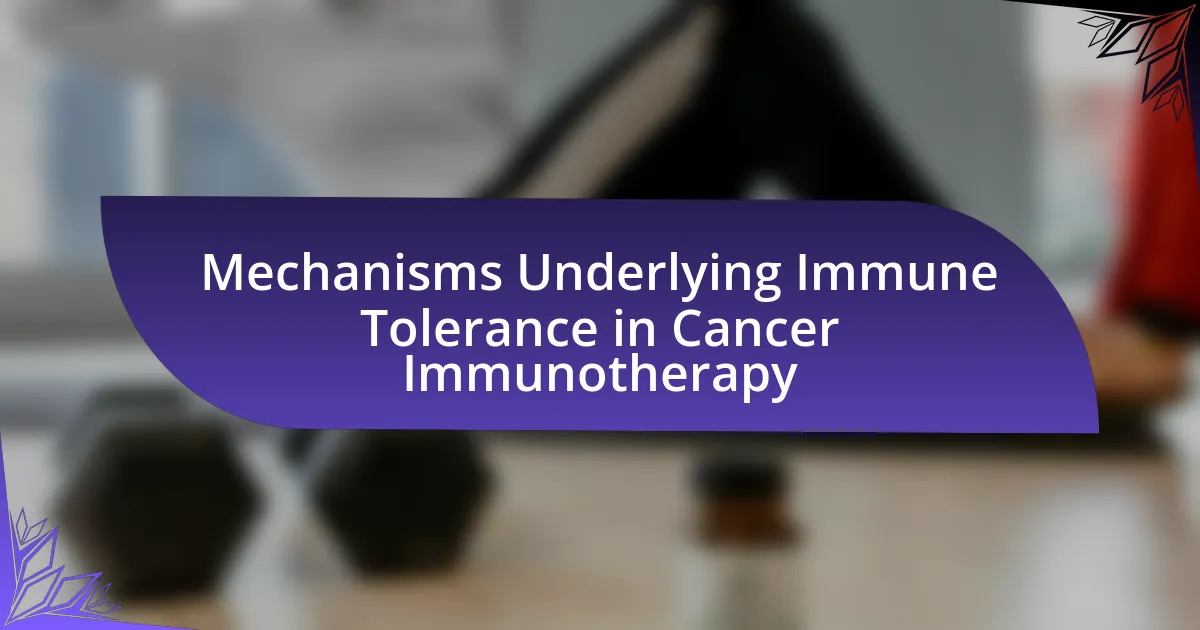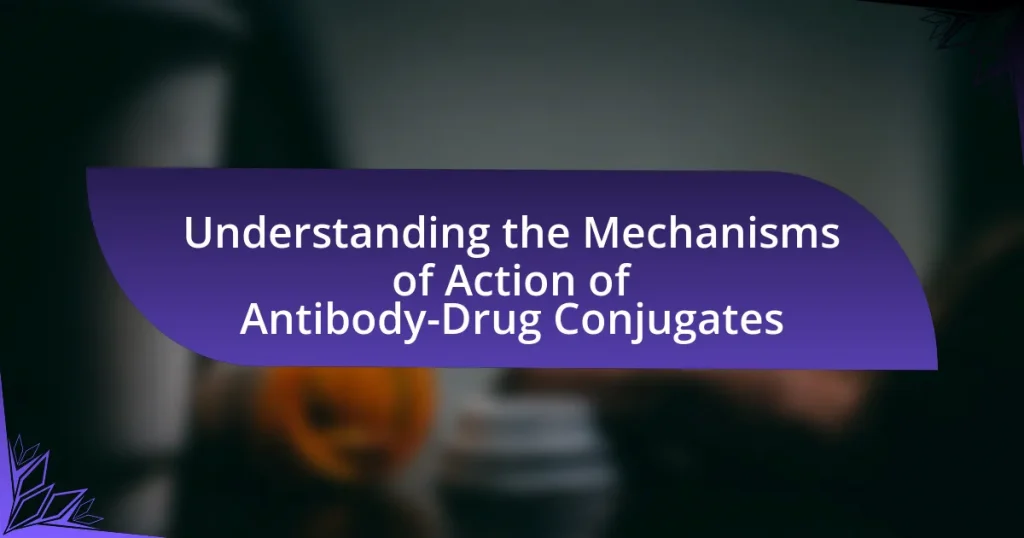The article focuses on the mechanisms underlying immune tolerance in cancer immunotherapy, highlighting how tumors evade immune detection through various pathways. Key factors contributing to immune tolerance include the upregulation of immune checkpoint molecules, the role of regulatory T cells, and the influence of the tumor microenvironment. The discussion emphasizes the negative impact of immune tolerance on treatment outcomes and explores strategies to overcome these barriers, such as checkpoint inhibition and combination therapies. Understanding these mechanisms is crucial for enhancing the effectiveness of cancer immunotherapy and improving patient responses.
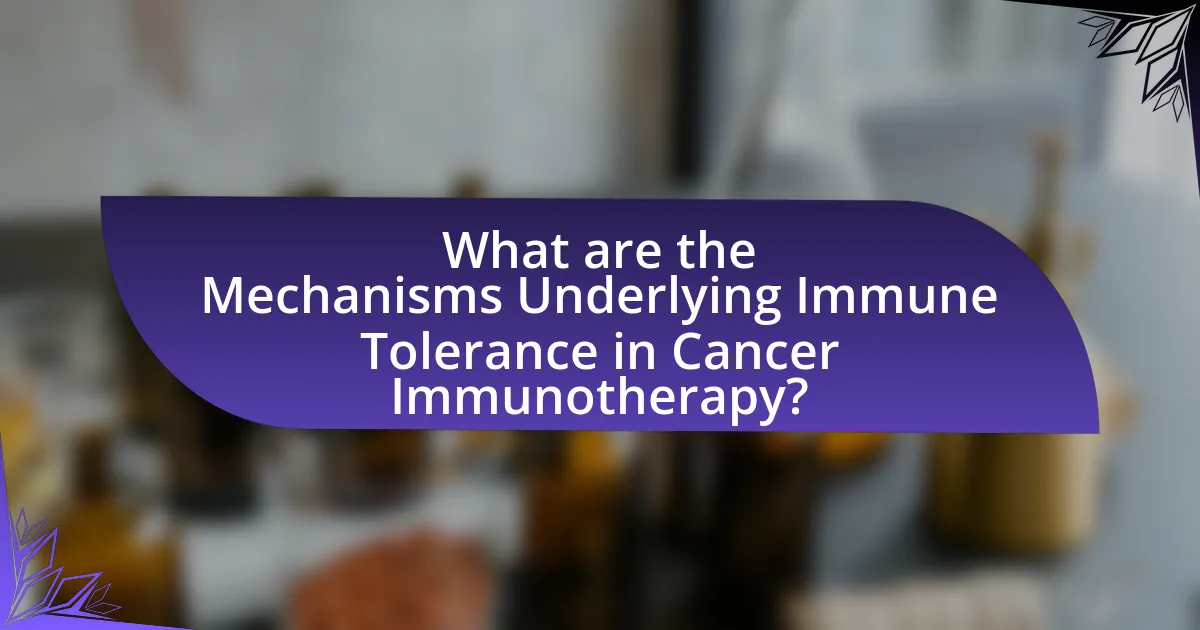
What are the Mechanisms Underlying Immune Tolerance in Cancer Immunotherapy?
The mechanisms underlying immune tolerance in cancer immunotherapy primarily involve the suppression of immune responses against tumor antigens. This occurs through various pathways, including the upregulation of immune checkpoint molecules such as PD-1 and CTLA-4, which inhibit T cell activation and proliferation. Additionally, regulatory T cells (Tregs) play a crucial role by maintaining immune homeostasis and preventing autoimmunity, often leading to the suppression of anti-tumor immunity. Tumors can also exploit the tumor microenvironment by secreting immunosuppressive cytokines like TGF-β and IL-10, which further promote immune tolerance. Studies have shown that these mechanisms can significantly hinder the effectiveness of cancer immunotherapies, emphasizing the need for strategies to overcome immune tolerance for improved therapeutic outcomes.
How does immune tolerance affect cancer treatment outcomes?
Immune tolerance negatively affects cancer treatment outcomes by allowing tumor cells to evade immune detection and destruction. This phenomenon occurs when the immune system becomes unresponsive to tumor antigens, leading to reduced efficacy of immunotherapies such as checkpoint inhibitors. Studies have shown that tumors can exploit immune tolerance mechanisms, such as regulatory T cells and immune checkpoint pathways, to suppress anti-tumor immune responses. For instance, research published in “Nature Reviews Cancer” highlights that high levels of regulatory T cells in the tumor microenvironment correlate with poor responses to immunotherapy, indicating that immune tolerance can significantly hinder treatment success.
What are the key factors contributing to immune tolerance in cancer?
Key factors contributing to immune tolerance in cancer include the presence of immunosuppressive cells, such as regulatory T cells and myeloid-derived suppressor cells, as well as the secretion of immunosuppressive cytokines like IL-10 and TGF-beta. These elements create an environment that inhibits effective anti-tumor immune responses. For instance, regulatory T cells can suppress the activation and proliferation of effector T cells, while myeloid-derived suppressor cells can inhibit T cell function and promote tumor growth. Additionally, tumor cells can express immune checkpoint molecules, such as PD-L1, which further dampen T cell activity. This combination of factors leads to a state of immune tolerance, allowing tumors to evade immune detection and destruction.
How do tumor microenvironments influence immune tolerance?
Tumor microenvironments influence immune tolerance by creating conditions that suppress immune responses against tumor cells. These environments are characterized by the presence of immunosuppressive cells, such as regulatory T cells and myeloid-derived suppressor cells, which inhibit the activation and function of effector T cells. Additionally, tumor cells can secrete various cytokines and growth factors, like TGF-beta and IL-10, that further promote immune suppression and tolerance. Studies have shown that the metabolic alterations within tumor microenvironments, including hypoxia and nutrient deprivation, also contribute to the dysfunction of immune cells, leading to an overall state of immune tolerance that allows tumors to evade detection and destruction by the immune system.
Why is understanding immune tolerance crucial for immunotherapy?
Understanding immune tolerance is crucial for immunotherapy because it directly influences the effectiveness of treatments aimed at enhancing the immune response against tumors. Immune tolerance refers to the mechanisms that prevent the immune system from attacking the body’s own cells, which can also lead to the suppression of anti-tumor immunity. For instance, regulatory T cells and immune checkpoint molecules, such as PD-1 and CTLA-4, play significant roles in maintaining this tolerance. Research has shown that tumors can exploit these pathways to evade immune detection, thereby diminishing the efficacy of immunotherapeutic agents. By comprehensively understanding immune tolerance, researchers can develop strategies to overcome these barriers, enhancing the potential for successful cancer immunotherapy.
What role does immune tolerance play in tumor progression?
Immune tolerance facilitates tumor progression by allowing cancer cells to evade immune detection and destruction. This occurs through mechanisms such as the expression of immune checkpoint molecules, which inhibit T-cell activation, and the secretion of immunosuppressive cytokines that create a microenvironment conducive to tumor growth. Studies have shown that tumors can exploit these pathways to maintain a state of immune tolerance, thereby promoting their survival and proliferation. For instance, the upregulation of PD-L1 on tumor cells interacts with PD-1 on T-cells, leading to T-cell exhaustion and reduced anti-tumor immunity. This dynamic illustrates how immune tolerance directly contributes to the advancement of cancer by undermining the body’s natural defense mechanisms.
How can immune tolerance be manipulated to enhance therapy effectiveness?
Immune tolerance can be manipulated to enhance therapy effectiveness by employing strategies such as checkpoint inhibition, adoptive cell transfer, and the use of immune-modulating agents. Checkpoint inhibitors, like anti-PD-1 and anti-CTLA-4 antibodies, disrupt the pathways that maintain immune tolerance, thereby allowing T cells to recognize and attack tumor cells more effectively. Adoptive cell transfer involves engineering T cells to overcome tolerance mechanisms, enhancing their ability to target cancer cells. Additionally, immune-modulating agents, such as cytokines or small molecules, can be utilized to shift the immune response from a tolerant state to an active state against tumors. These approaches have shown promise in clinical trials, demonstrating improved patient responses and survival rates in various cancers.
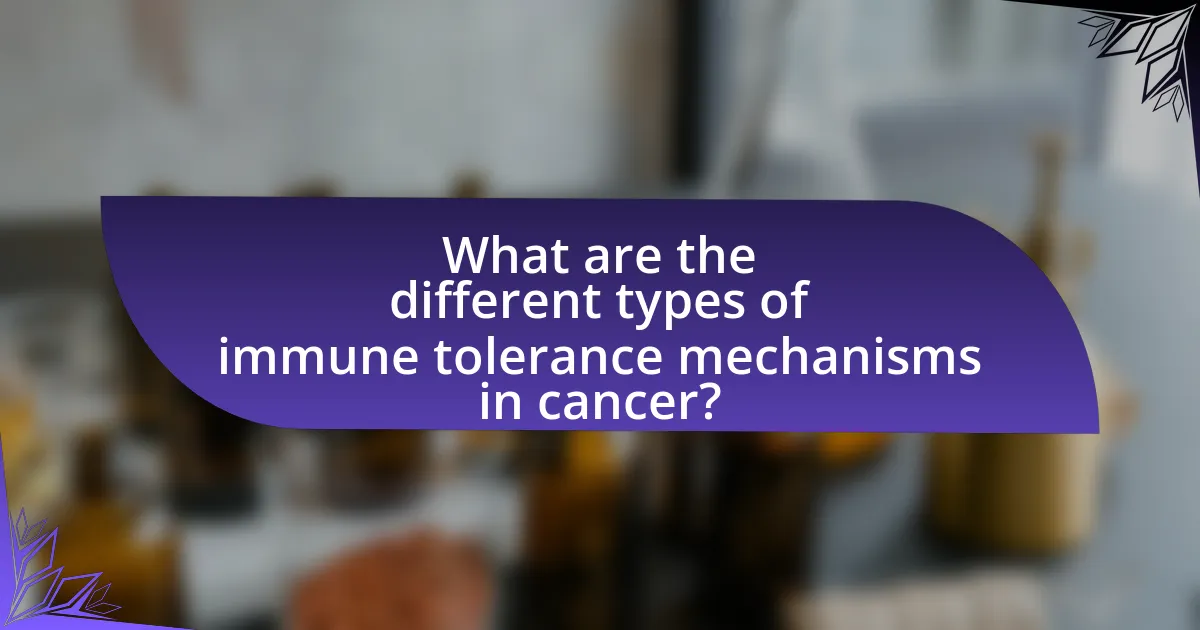
What are the different types of immune tolerance mechanisms in cancer?
The different types of immune tolerance mechanisms in cancer include central tolerance, peripheral tolerance, and tumor-induced tolerance. Central tolerance occurs during the development of immune cells in the thymus and bone marrow, where self-reactive cells are eliminated or rendered inactive. Peripheral tolerance involves mechanisms that prevent activated immune cells from attacking normal tissues, including anergy, regulatory T cells, and immune checkpoint pathways. Tumor-induced tolerance refers to the ability of tumors to create an immunosuppressive microenvironment, often through the secretion of cytokines and the expression of immune checkpoint molecules, which inhibit T cell activation and function. These mechanisms collectively contribute to the evasion of immune surveillance by cancer cells, allowing tumors to grow and metastasize.
How do central and peripheral tolerance mechanisms differ?
Central tolerance mechanisms occur during the development of immune cells in the thymus and bone marrow, where self-reactive cells are eliminated or rendered non-functional, ensuring that the immune system does not attack the body’s own tissues. In contrast, peripheral tolerance mechanisms operate outside of these primary lymphoid organs and involve various processes, such as anergy, deletion, and regulation by regulatory T cells, to control self-reactive immune cells that have escaped central tolerance. The distinction is critical, as central tolerance primarily prevents the generation of autoreactive lymphocytes, while peripheral tolerance manages those that have already entered the circulation, thereby maintaining immune homeostasis and preventing autoimmunity.
What are the cellular components involved in central tolerance?
The cellular components involved in central tolerance include thymocytes, dendritic cells, and regulatory T cells. Thymocytes undergo selection processes in the thymus, where those that strongly recognize self-antigens are eliminated, a process known as negative selection. Dendritic cells present self-antigens to thymocytes, facilitating the identification of self-reactive cells. Regulatory T cells, which develop in the thymus, play a crucial role in maintaining tolerance by suppressing the activation of self-reactive T cells in the periphery. These components work together to ensure that the immune system does not mount an attack against the body’s own tissues, thereby preventing autoimmune responses.
How does peripheral tolerance contribute to immune evasion in tumors?
Peripheral tolerance contributes to immune evasion in tumors by allowing cancer cells to escape detection and destruction by the immune system. This occurs through mechanisms such as the induction of regulatory T cells, which suppress immune responses against tumor antigens, and the expression of immune checkpoint molecules like PD-L1 on tumor cells, which inhibit T cell activation. Studies have shown that tumors can exploit these pathways to create an immunosuppressive microenvironment, thereby facilitating their growth and survival. For instance, the presence of regulatory T cells in the tumor microenvironment has been associated with poor prognosis in various cancers, highlighting the role of peripheral tolerance in enabling tumor immune evasion.
What are the roles of regulatory T cells in immune tolerance?
Regulatory T cells (Tregs) play a crucial role in maintaining immune tolerance by suppressing excessive immune responses and preventing autoimmunity. They achieve this through various mechanisms, including the secretion of anti-inflammatory cytokines such as IL-10 and TGF-β, which inhibit the activation and proliferation of effector T cells. Additionally, Tregs can directly interact with other immune cells, such as dendritic cells and effector T cells, to modulate their activity and promote a state of tolerance. Studies have shown that the presence of Tregs in tumor microenvironments can contribute to immune evasion by tumors, as they suppress anti-tumor immune responses, thereby facilitating cancer progression.
How do regulatory T cells suppress anti-tumor immune responses?
Regulatory T cells suppress anti-tumor immune responses primarily through the secretion of immunosuppressive cytokines, such as IL-10 and TGF-β, which inhibit the activation and proliferation of effector T cells. These cells also express surface molecules like CTLA-4 and PD-1 that can directly inhibit the function of other immune cells, including dendritic cells and cytotoxic T lymphocytes. Additionally, regulatory T cells can modulate the tumor microenvironment by promoting the recruitment of myeloid-derived suppressor cells, further dampening the anti-tumor immune response. This suppression is critical in maintaining immune tolerance, which can inadvertently allow tumors to evade immune detection and destruction.
What strategies can target regulatory T cells in cancer therapy?
Strategies to target regulatory T cells in cancer therapy include the use of monoclonal antibodies, small molecule inhibitors, and adoptive cell transfer techniques. Monoclonal antibodies, such as anti-CTLA-4 and anti-PD-1, can deplete or inhibit the function of regulatory T cells, enhancing anti-tumor immunity. Small molecule inhibitors, like those targeting the PI3K pathway, can disrupt the signaling pathways that promote regulatory T cell survival and function. Additionally, adoptive cell transfer of effector T cells can be employed to outcompete regulatory T cells in the tumor microenvironment. These strategies have been supported by clinical trials demonstrating improved patient outcomes when regulatory T cell activity is effectively modulated.
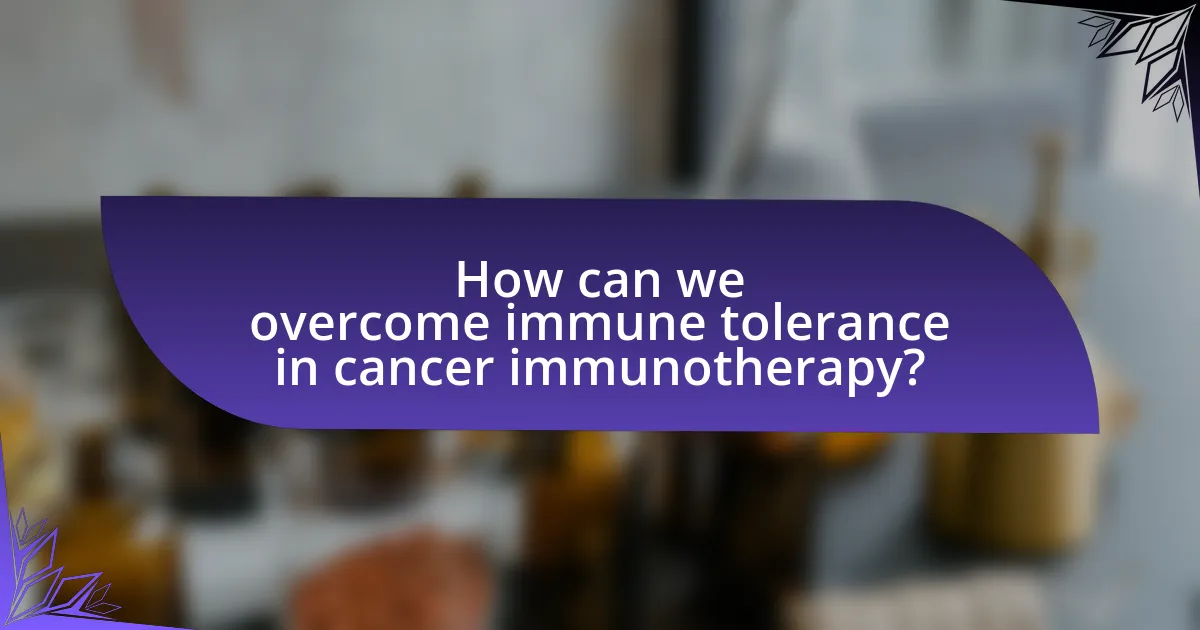
How can we overcome immune tolerance in cancer immunotherapy?
To overcome immune tolerance in cancer immunotherapy, strategies such as checkpoint inhibition, combination therapies, and the use of adjuvants can be employed. Checkpoint inhibitors, like anti-PD-1 and anti-CTLA-4 antibodies, block inhibitory signals that prevent T cells from attacking cancer cells, thereby enhancing immune responses. Combination therapies, which involve using multiple immunotherapeutic agents or combining immunotherapy with traditional treatments like chemotherapy or radiation, can further stimulate the immune system and reduce tolerance. Additionally, adjuvants can be used to boost the immune response by enhancing antigen presentation and T cell activation. These approaches have shown efficacy in clinical trials, demonstrating improved patient outcomes and reduced immune tolerance in various cancer types.
What therapeutic strategies are being developed to counteract immune tolerance?
Therapeutic strategies being developed to counteract immune tolerance include immune checkpoint inhibitors, adoptive cell transfer, and targeted therapies aimed at modulating the tumor microenvironment. Immune checkpoint inhibitors, such as anti-PD-1 and anti-CTLA-4 antibodies, work by blocking pathways that inhibit T-cell activation, thereby enhancing the immune response against tumors. Adoptive cell transfer involves the infusion of T cells that have been engineered to recognize and attack cancer cells, effectively bypassing tolerance mechanisms. Additionally, targeted therapies that disrupt immunosuppressive factors in the tumor microenvironment, such as regulatory T cells and myeloid-derived suppressor cells, are being explored to restore immune function. These strategies are supported by clinical trials demonstrating improved patient outcomes in various cancers, highlighting their potential effectiveness in overcoming immune tolerance.
How do checkpoint inhibitors work to enhance immune responses?
Checkpoint inhibitors enhance immune responses by blocking proteins that inhibit T-cell activation, thereby allowing the immune system to recognize and attack cancer cells more effectively. These inhibitors target immune checkpoint proteins such as PD-1, PD-L1, and CTLA-4, which normally act as brakes on the immune response. By inhibiting these checkpoints, T-cells can remain active longer and exert their cytotoxic effects on tumor cells. Clinical studies have shown that checkpoint inhibitors can lead to significant tumor regression in various cancers, demonstrating their efficacy in enhancing immune responses against malignancies.
What is the potential of combination therapies in overcoming tolerance?
Combination therapies have significant potential in overcoming tolerance in cancer immunotherapy by targeting multiple pathways simultaneously. This approach can enhance the immune response against tumors, as evidenced by studies showing that combining immune checkpoint inhibitors with other modalities, such as targeted therapies or vaccines, can lead to improved patient outcomes. For instance, research published in the Journal of Clinical Oncology demonstrated that the combination of nivolumab and ipilimumab resulted in higher response rates compared to monotherapy, indicating that dual blockade of immune checkpoints can effectively counteract tolerance mechanisms. Thus, the strategic use of combination therapies can disrupt the tumor’s ability to evade immune detection, ultimately improving therapeutic efficacy.
What are the challenges in targeting immune tolerance in cancer treatment?
Targeting immune tolerance in cancer treatment faces several challenges, primarily due to the complexity of the immune system and tumor microenvironment. One significant challenge is the ability of tumors to exploit immune checkpoints, which can inhibit T-cell activation and promote immune evasion. For instance, cancer cells often express ligands for PD-1 and CTLA-4, leading to T-cell exhaustion and reduced anti-tumor responses. Additionally, the heterogeneity of tumors means that not all cancer cells respond uniformly to immune therapies, complicating treatment strategies. Research indicates that the presence of immunosuppressive cells, such as regulatory T cells and myeloid-derived suppressor cells, further contributes to immune tolerance, making it difficult to achieve effective immune activation against tumors. These factors collectively hinder the development of successful immunotherapeutic approaches aimed at overcoming immune tolerance in cancer.
How do individual patient variations affect treatment outcomes?
Individual patient variations significantly affect treatment outcomes in cancer immunotherapy due to differences in genetic makeup, immune system functionality, and tumor microenvironment. Genetic variations can influence how patients metabolize drugs, respond to therapies, and develop immune responses, which directly impacts efficacy and safety. For instance, polymorphisms in genes related to immune checkpoints, such as PD-1 and CTLA-4, can alter the effectiveness of checkpoint inhibitors, leading to varied responses among patients. Additionally, the presence of specific biomarkers, such as tumor mutational burden, can predict which patients are more likely to benefit from immunotherapy. Studies have shown that patients with high mutational burden tend to have better responses to therapies like pembrolizumab. Therefore, understanding these individual variations is crucial for personalizing treatment strategies and improving overall outcomes in cancer immunotherapy.
What are the risks associated with disrupting immune tolerance?
Disrupting immune tolerance can lead to autoimmune diseases, where the immune system mistakenly attacks the body’s own tissues. This occurs because the mechanisms that normally prevent immune responses against self-antigens are compromised, resulting in increased inflammation and tissue damage. For example, conditions such as rheumatoid arthritis and lupus can arise when immune tolerance is disrupted, as evidenced by studies showing elevated autoantibody levels in these diseases. Additionally, the disruption can lead to excessive immune activation, which may cause severe adverse effects in cancer immunotherapy, including cytokine release syndrome and immune-related adverse events, as reported in clinical trials involving checkpoint inhibitors.
What best practices can be implemented to improve cancer immunotherapy outcomes?
To improve cancer immunotherapy outcomes, implementing combination therapies that include immune checkpoint inhibitors and targeted therapies is essential. Studies have shown that combining these approaches can enhance the immune response against tumors, leading to better patient outcomes. For instance, a clinical trial published in the Journal of Clinical Oncology demonstrated that patients receiving a combination of pembrolizumab (an immune checkpoint inhibitor) and chemotherapy had a significantly higher overall survival rate compared to those receiving chemotherapy alone. Additionally, optimizing patient selection through biomarker testing can identify individuals most likely to benefit from immunotherapy, further improving treatment efficacy.
